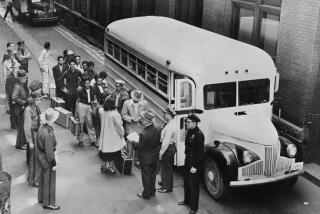Red Tape Snags Green Cross Statue : Landmarks: The monument has known both fame and oblivion since it was dedicated 62 years ago. Now its restoration has encountered a setback.
- Share via
Her face is scarred and her arms are gone. She can no longer stand up without help. She spent years lost and neglected in an obscure Brand Park canyon, where vandals took potshots at her and the elements eroded her features.
But Glendale officials say better days are ahead for Miss American Green Cross, a 62-year-old statue that was erected amid great fanfare by American Green Cross, a now-defunct organization committed to saving the nation’s forests.
City leaders say the statue has historic value, and they plan to spend thousands of dollars to restore her arms, refinish her bronze skin, rebuild her pedestal and put her back on public display.
Support for the project remains strong, but the restoration of Miss American Green Cross suffered a slight setback last month.
Glendale parks officials had chosen for the project local sculptor Ron Pekar, who said he could complete the work by November for $25,000. He said he would use modern materials that are more durable and vandal-resistant than the concrete-like substance originally used to form the cross behind the statue and the cluster of logs at her feet.
But the Glendale Historic Preservation Commission gave the proposal a cool reception at its Sept. 17 meeting.
“The commission prefers to see it restored to its original condition in both materials and design,” Commissioner William E. Dodson said. “We’re to protect what is historic in the city and try to retain it as much as possible in its original condition.
“To do less, you’re really not restoring, you’re creating something new. We wouldn’t have Miss American Green Cross. We’d have a new project,” he said.
A further complication arose shortly before the meeting, when a Glendale history buff unearthed some old photos of the statue at the Los Angeles Library. They showed that it originally stood upon a six-foot-high base, with inscriptions proclaiming the importance of forests.
“Obviously, it was a surprise to us,” said Nello Iacono, the city’s parks and recreation director. “We had never seen that base.”
Artist Pekar suggested that the mammoth base, if rebuilt, would dwarf the delicate five-foot-tall statue and detract from her beauty. Its size would also spoil a plan to put the statue in a small landscaped area near the Brand Library.
But the Historic Preservation Commission urged that the large base be rebuilt because it was part of the original monument. “It’s not so much the artistic quality. It’s the history behind it that’s important,” Dodson said.
Iacono has asked Pekar to draw up a new budget and schedule for rebuilding the base and restoring the statue with original materials. The new budget is expected to be higher and the project may not be completed until next spring, the parks director said.
Dodson is not worried about the delay.
“Time is not of the essence here,” he said. “The quality is more important than the time element.”
Although she was briefly the center of civic attention, time has not been kind to Miss American Green Cross.
Thousands of cheering onlookers attended her unveiling at the Glendale High School campus on April 23, 1928. On May 4, California’s governor at the time, C. C. Young, placed a strongbox filled with mementos in the monument’s cornerstone after being escorted to the campus by a parade of more than 100 cars.
The statue was a focal point for American Green Cross, but little is known today about the organization. Glendale officials have been unable to find any chapters that still exist.
According to old news articles, the group was founded in Southern California on Dec. 3, 1926, as a successor to the American Reforestation Assn. It promoted the conservation of timber and other natural resources. Its leaders said the destruction of forests, which absorb rain, had contributed to serious flooding problems nationwide.
One early Green Cross committee chairman urged that the group’s national headquarters be established in his hometown, Santa Barbara, “because there are so many people here who have time to think about the important things of life.”
Instead, the headquarters was established in early 1928 at Glendale’s Sparr Heights community center, which was donated to the group. On April 5, 1928, Glendale also became the site of the nation’s first local Green Cross chapter.
The organization made plans to place its first Green Cross monument at Glendale High School. Little is known about its sculptor, Frederick Willard Potter, or his model, Verlyn Sumner, although they were on the speakers’ platform during the unveiling of Miss American Green Cross.
A Times report on the event said, “The monument portrays America as a woman standing before a green cross with outstretched arms amid ruined stumps crying, ‘Help Save Our Trees.’ ”
Beneath that plea was the inscription: “The Forest Is the Mother of the Rivers.” Other conservation messages also appeared on the base.
In the years that followed, American Green Cross’ popularity apparently waned, as did the city’s enthusiasm for the statue. According to old news reports, art critics of the era dismissed the statue as “an abortion.” One report said its base was damaged when “a wildly driven car banged into it.”
Sometime during the early 1930s, Miss American Green Cross was spirited away from the high school campus and deposited in the remote canyon area.
She briefly re-entered the limelight in 1954, when reporters hiking in the Brand Park canyon stumbled upon the statue and dubbed it the mysterious “Green Cross Woman.” The mystery was solved a few days later when the Glendale City Council, accompanied by civic activist Essie Morris Hughes, journeyed into the brush to inspect the find.
“There’s my statue!” exclaimed Hughes, who had founded the Junior Green Cross chapter for Glendale’s schoolchildren many years earlier. Council members joked about who had removed the monument, “but not one suggestion was heard that she be returned to her place on Glendale High School grounds,” the Glendale Independent reported.
Miss American Green Cross remained in the canyon and was heavily damaged by vandals. Glendale’s Historic Preservation Element, adopted in 1977, designated the statue as a landmark piece that should be relocated to a prominent place in Brand Park.
By the early 1980s, her arms were gone, and her cross and logs had crumbled, parks director Iacono said. Since 1981, she has remained in storage at Brand Park’s maintenance yard.
In 1985, the Historic Preservation Commission was formed to take a more aggressive role in saving important Glendale buildings and artifacts.
During an Arbor Day speech last March, Iacono said the city’s goal was to complete the monument’s restoration by the end of the year, to coincide with the renovation of the park. He said the founders of American Green Cross were visionary and their message more timely than ever, in view of the current international concern over the loss of rain forests.
“Let the restoration and permanent placement of Miss American Green Cross reaffirm our commitment to trees and the integral part they play in our environment,” Iacono said.
More to Read
Sign up for Essential California
The most important California stories and recommendations in your inbox every morning.
You may occasionally receive promotional content from the Los Angeles Times.










